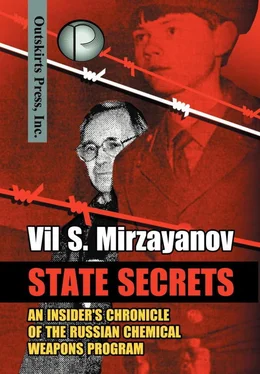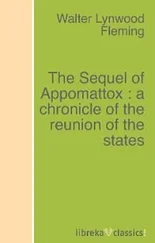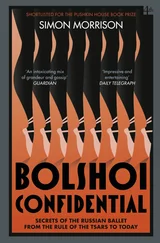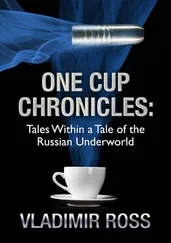Kondratiev willingly worked for a long time at the Shikhany branch of GOSNIIOKhT, where he was able to defend his doctoral dissertation, with the help of Ivin. Thanks to his ties of kinship with one of the members of the Politburo of the Central Committee of the CPSU, Kondratiev quickly became director of a prominent newly organized scientific institute – the All Union Scientific Research Institute for the Chemical Defense of Plant Life (VNIISKhZR) in Moscow.
Since he did not have any kind of specialization in organizational work and was amazingly inarticulate, this scientist from Shikhany, who was promoted to an administrative post, quickly botched his job at the institute. After that, they transferred him to GOSNIIOKhT, where he resides to this day, because there, as nowhere else, he began to feel at home in the world of secrecy, with his lack of talent and his terrifying conservatism.
A more talented student of Ivin’s, Yury Gololobov, was forced out of GOSNIIOKhT by the envious director, who didn’t want to have anything to do with him. There was another large-scale laboratory at GOSNIIOKhT for the synthesis of new chemical agents headed up by Professor Boris M. Gladstein, a man who I respected professionally and developed a highly positive impression of. In the past some of my colleagues frequently hinted that Professor Gladstein had more than a close relationship with the GRU.
I developed a series of GC procedures for the study of the so-called thion-thiol isomerization (it formed the basis for the American binary weapon), which the workers in Gladstein’s laboratory used intensively. It seems to me that this lab did not achieve any particular success, although the staff was comprised of highly talented scientists.
Gladstein used all of his promotional talents to push ahead with “Substance 100-A” and “Substance 100-B”, which were analogues of Substance 33. The difference lay in the substitution of O-iso-butyl radicals by O-cyclopentyl and O-methylcyclopentyl radicals accordingly. The patent for these compounds belongs to the prominent military chemist, Abram Bruker. The technology of the production of cyclopentyl and methylcyclopentyl alcohols was developed by my longtime friend Professor Yevgeny Yevzirikhin.
Bruker and another scientist of this laboratory Leonid Soborovski developed a method of oxidizing phosphorylization, which was used to easily obtain the precursors needed for the synthesis of phosphoorganic chemical agents on an industrial scale.
Under the energetic support of GOSNIIOKhT Director Ivan Martynov, Substances 100-A and 100-B went through extensive testing. The results of this testing can be found in the text of the doctoral dissertation of Grigory Patrushev, who was then chief of the Department of Medical Biological Research and later became a director of GOSNIIOKhT.
Nevertheless, these compounds appeared to have little promise, considering that the industrial technology for manufacturing Substance 33 had already been mastered at the Novocheboksary Factory, and a new wave of research had begun on the binary weapons. For this reason, the subject of “Substances 100-A and 100-B” became a closed one. There is a real possibility that this theme was originally planted by the American agent Joseph Cassidy, who fed information about a relatively useless chemical agent to General Mikhael Danilin, who was the chief spy for the GRU (General Intelligence Directorate of the Soviet Army). [27] David Wise. Cassidy’s Run : The Secret Spy War Over Nerve Gas. (New York: Random House, 2000).
The laboratory for the synthesis and research of the psychotropic compounds was under the leadership of Professor Nikolai Yarovenko, who came to GOSNIIOKHT from TSNIVTI along with Ivin.
Psychotropic compounds are strong agents affecting the human psyche, based on chinuclidine ethers (one analogue known in the West is BZ). [28] BZ is short for 3-Quinuclidinyl benzilate. BZ is an anticholinergic, a category of drugs that includes antihistamines, antidepressants, and antipsychotics. Depending on the dosage, the effects of BZ range from mild drowsiness to loss of coordination, dulled thought process, confusion, paranoia, delirium, and hallucination. These symptoms generally appear several hours after exposure to BZ and can last for up to 96 hours. For more information, see James Ketchum and Frederick R. Sidell, “Incapacitating Agents,” Textbook of Military Medicine , pp.296.
According to Yarovenko’s account, such a compound would cause a soldier to smile happily and have beautiful dreams, setting aside his weapon. Yarovenko drew a detailed picture of such hallucinations, after coming from Leningrad, where several students in the Military Medical Academy had voluntarily tested this preparation on themselves.
The activities of this laboratory were considered very successful, since BZ, under the code name of “Substance 78”, successfully passed through testing, and its production was achieved on an industrial scale at the Volsk branch (Shikhany) of GOSNIIOKhT. Our own Laboratory 25 participated in this work in a big way during the time of the start-up of the pilot plant.
Also, one of the analogues of BZ was determined to be a good anesthetic (by Doctors of Chemical Science Felix Dukhovich and Elena Gorbatova.) For that reason, the analogue was produced at the experimental plant of GOSNIIOKhT, and sent to the Burdenko Military Hospital in Moscow.
After Yarovenko’s death in early 1980, Victor Komarov, a retired colonel and former professor at the Military Academy of Chemical Defense, replaced him. It seems that you can’t call his activities successful, since bit by bit the laboratory plunged into a routine, researching basic compounds of a less significant nature. For example, for a long time they seriously researched a compound which stimulated nausea. It was thought that once it had worked its effect on a soldier, he would tear off his gas mask, because the nausea was intolerable, and after that the real chemical agent could kill him. What a nightmare!
What could we Soviets do if double agent Cassidy did a brilliant job, and we spent a lot of resources, without getting any positive results? Nevertheless, I was forced to participate in this work, researching methods for determination of micro-concentrations of this preparation.
Another prominent laboratory, headed by Professor Vsevolod Ginsburg, was devoted for a long time to searching for specialized natural compounds that could kill people. It seems to me that they succeeded in isolating and purifying the strong and naturally poisonous protein of ricin, found in plants of the castor bean family. As far as I know, a large volume of work was performed there by Doctor of Chemical Science Natalya Merzabekova, who studied the amino acid sequence of the protein, after the purification of raw materials and so forth. The technological research, for the completion of an experimental reactor, was authored by my good friend and neighbor, Evgeni Chizhov, who said he had worked closely with Natalia Merzabekova and Valeri Demidyuk. The later had defended his master’s dissertation on the theme of the chromatographic isolation of pure ricin.
Demidyuk was notable for his “creeper vine-like” character, being a model orthodox Communist. This trait evidently became crucial in his appointment to the post of Chief Consultant to a new journal pretentiously titled Chemical Weapons and Problems of Their Destruction , which came out of Russia, thanks to different sources of American funds.
Under Chizhov’s leadership in the beginning of 1970, a pilot plant was opened at the Volsk branch of GOSNIIOKhT, in order to produce the quantity of ricin necessary for field testing.
Ricin is the strongest poison, surpassing all phosphoorganic chemical agents in toxicity. It does not leave any traces in the organism of the victim, making forensic work practically impossible. On the other hand, most specialists know that it possesses almost insurmountable shortcomings in its application, which would prevent it from meeting the standards needed for broad field testing. In particular, ricin loses all its toxic characteristics at only 50 degrees Celsius. Also, it has practically no vapor pressure at the normal temperatures at which its aerosol form would be dangerous for people, since it is a compound with a high molecular weight. For this reason, in order to poison someone with ricin, it is necessary to introduce the poison by injection or by another manner, for example by ingestion.
Читать дальше












